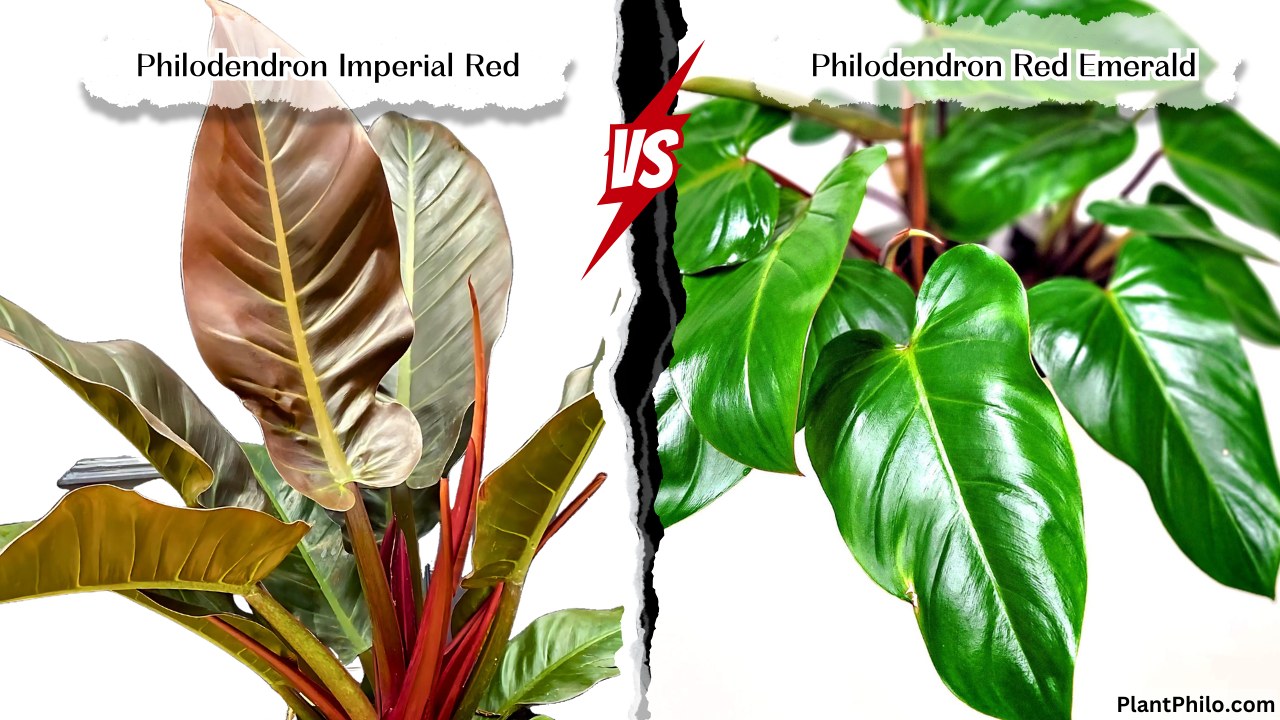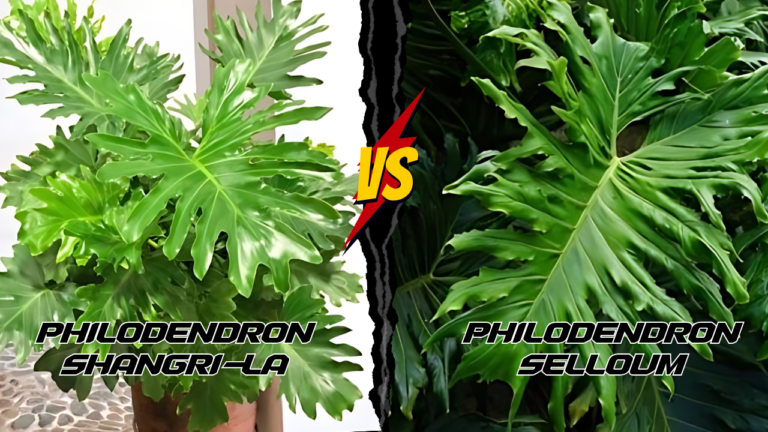Imperial Red vs. Red Emerald: Key Differences, One Tough Choice
The allure of ruby-red foliage beckons, but which Philodendron reigns supreme? The Imperial Red, with its regal bearing, or the Red Emerald, sparkling with vibrancy? Choosing between these two can leave even seasoned plant enthusiasts scratching their heads.
But fear not. Let’s embark on a journey through the nuances of these two beauties, ensuring you pick the perfect crimson jewel for your collection.
Comparison Table: Philodendron Imperial Red vs. Red Emerald
| Feature | Philodendron Imperial Red | Philodendron Red Emerald |
| Leaf Shape & Size | Large, oval, paddle-shaped | Smaller, elongated, heart-shaped |
| Growth Habit | Upright, compact | Climbing or vining with support |
| Color | Deep burgundy to bronze-red with hints of green | Vibrant, bright red with hints of orange and green |
| Light Requirements | Bright, indirect light for optimal color; tolerates low light | Bright, indirect light; some direct morning sun can intensify color |
| Watering Needs | Water when top 2-3 inches of soil are dry | Water when top inch of soil is dry |
| Humidity | Appreciates higher humidity, but tolerates average levels | Thrives in higher humidity |
| Fertilizing | Balanced liquid fertilizer monthly during growing season | Balanced liquid fertilizer every 2-3 weeks during growing season |
| Common Pests & Diseases | Mealybugs, scale, spider mites | Mealybugs, scale, spider mites |
| Propagation | Stem cuttings | Stem cuttings |
| Toxicity | Toxic to pets and humans if ingested | Toxic to pets and humans if ingested |
| Petiole | Thick, sturdy | Slender, flexible |
| Stem | Thick, upright | Thinner, vining |
| New Leaf Color | Deep red, maturing to burgundy | Bright red, maturing to a deeper red |
| Air Purifying | Moderate air purifying qualities | Moderate air purifying qualities |
| Overall Difficulty | Easy to care for | Moderately easy to care for |
In-Depth Comparison
1. Leaf Shape and Size
The Imperial Red lives up to its name with imposing, paddle-shaped leaves that can reach impressive sizes. Picture a bold, heart-stopping statement piece gracing your living room.
In contrast, the Red Emerald offers a more delicate charm with its smaller, heart-shaped leaves. Think of it as a collection of sparkling rubies adorning a lush vine.
2. Growth Habit
The Imperial Red maintains a dignified, upright posture, perfect for those seeking a self-heading centerpiece. It’s the strong, silent type, adding grandeur without demanding the spotlight.
The Red Emerald, however, has a more adventurous spirit. It’s a climber at heart, eager to explore its surroundings with the help of a moss pole or trellis.
3. Color
Both plants showcase a captivating spectrum of reds but with subtle variations. The Imperial Red leans towards deeper shades, ranging from burgundy to bronze-red, often with hints of green peeking through. It’s like a fine wine, rich and complex.
The Red Emerald, true to its name, dazzles with a vibrant, bright red that can even have hints of orange. It’s the fiery gem that catches the eye and ignites the imagination.
4. Light Requirements
Both plants crave bright, indirect light to maintain their fiery hues. However, the Red Emerald has a slight edge, as it can tolerate and even benefit from some direct morning sun. Think of it as a sunbather, soaking up the early rays to enhance its vibrant glow. The Imperial Red, while adaptable to lower light, might lose some of its color intensity in shadier spots.
5. Watering Needs
Neither plant appreciates soggy feet, but their watering needs differ slightly. The Imperial Red, with its thicker leaves and stems, can hold onto moisture for longer. So, allow the top 2-3 inches of soil to dry out before reaching for the watering can.
The Red Emerald, with its thinner leaves, prefers a slightly more frequent watering schedule. Aim to water it when the top inch of soil feels dry.
6. Humidity
Hailing from tropical rainforests, both plants relish higher humidity levels. Think of it as their way of reminiscing about their humid homeland. While they can tolerate average household humidity, misting them regularly or using a pebble tray can help them flourish and prevent those dreaded crispy leaf tips.
7. Fertilizing
Both plants are hungry for nutrients during their growing season (spring and summer). The Red Emerald, with its faster growth rate, appreciates a bit more frequent feeding.
A balanced liquid fertilizer every 2-3 weeks will keep it thriving. The Imperial Red, while still needing regular nourishment, can usually get by with monthly fertilization.
Common Pests & Diseases
Both plants can fall victim to common houseplant pests like mealybugs, scale, and spider mites. Keep a watchful eye for any signs of infestation and act promptly to prevent them from spreading. Remember, a healthy plant is a happy plant, and a happy plant is less susceptible to pests and diseases.
1. Propagation: Sharing the Love
Want to spread the joy of these ruby reds? Both plants can be easily propagated from stem cuttings. It’s like sharing a piece of your heart (or plant, in this case) with fellow plant enthusiasts.
2. Toxicity: A Word of Caution
While these plants are a feast for the eyes, they’re not meant for consumption. Both contain calcium oxalate crystals, which can cause irritation and swelling if ingested by pets or humans. So, admire their beauty from a safe distance and keep them out of reach of curious paws and mouths.
3. Petiole, Stem & New Leaf Color: Subtle Clues
Pay attention to these details for a deeper understanding of each plant. The Imperial Red has thick, sturdy petioles (leaf stalks) and stems, reflecting its robust nature. Its new leaves unfurl in a deep red, gradually maturing to a rich burgundy.
The Red Emerald, with its slender, flexible petioles and vining stems, showcases a more delicate structure. Its new leaves emerge in a vibrant red. And as it turns, deepening red as they mature.
4. Air Purifying: A Breath of Fresh Air
Both the Imperial Red and Red Emerald contribute to cleaner indoor air by removing certain toxins. While they might not replace a dedicated air purifier, they’re a welcome addition to any health-conscious home.
5. Overall Difficulty: Nurturing Your Gems
Both plants are relatively easy to care for, but the Imperial Red might have a slight edge for beginners due to its slower growth rate and slightly lower humidity requirements. The Red Emerald, while still manageable, demands a bit more attention to maintain its optimal color and growth habit.
FAQs
Which plant is better for low-light conditions?
The Philodendron Imperial Red is more tolerant of low light, but its color might be less intense.
Which plant grows faster?
The Philodendron Red Emerald typically grows faster, especially when provided with a climbing structure.
Can I train my Red Emerald to climb?
Absolutely! Provide it with a moss pole or trellis and gently guide its vines upwards.
Why are the new leaves on my Imperial Red green?
New leaves often emerge green and gradually develop their red coloration as they mature.
How can I intensify the red color of my plants?
Provide bright, indirect light, and consider giving the Red Emerald some direct morning sunlight.
Can I propagate these plants in water?
Yes, both plants can be propagated in water, but rooting in soil is generally faster and more successful.
What should I do if I see pests on my plant?
Isolate the infested plant and treat it with insecticidal soap or neem oil.
Why are the leaves on my plant turning yellow?
Yellowing leaves can indicate overwatering, underwatering, or nutrient deficiencies.
Can I grow these plants outdoors?
Yes, in warm climates, but they need protection from harsh afternoon sun.
Which plant is rarer and more expensive?
The Philodendron Red Emerald is generally considered rarer and can be more expensive than the Imperial Red.
Choose Your Ruby Red
The choice between the Philodendron Imperial Red and Red Emerald boils down to your personal preferences and space. If you crave a bold, self-heading statement with deep red hues, the Imperial Red is your match. If you envision a vibrant, climbing vine with fiery red leaves, the Red Emerald will steal your heart.
Remember, both plants bring a touch of tropical elegance and drama to any space. With proper care and attention, they’ll reward you with their stunning foliage for years to come.



